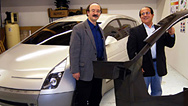Carbon-Fiber Car of the Future
- Teacher Resource
- Posted 08.26.08
- NOVA
In this video segment adapted from NOVA, hear physicist and energy expert Amory Lovins explain how to make more efficient cars by making them lighter and more aerodynamic. Explore how the use of carbon fiber can reduce weight without reducing size or durability, and learn about some manufacturing challenges associated with using carbon fiber materials.
Permitted use:
![]() Download and Share
Download and Share


- Media Type: Video
- Running Time: 5m 03s
- Size: 15.0 MB
- Level: Grades 6-12
-
Log in to Teachers' Domain to download, share, rate, save, and match to state standards.
Source: NOVA: "Car of the Future"
This media asset was adapted from NOVA : "Car of the Future".
Background
The use of fuel in cars produces a significant amount of carbon dioxide, a greenhouse gas that traps heat in the atmosphere and has been implicated in global climate change. Cars that are designed to be more efficient—able to travel farther per unit of fuel—could help to reduce greenhouse emissions. For example, if cars were lighter, the efficiency of the cars could be greatly increased. As technologies improve, the future holds promise for building lighter cars using a material known as a carbon fiber composite.
Composite materials are made from two or more component materials: a "matrix" material surrounds a "reinforcement" material to form a new material with special properties. In the case of carbon fiber composites (often referred to simply as carbon fiber), a matrix material of resin (a substance that hardens with treatment) surrounds threads of carbon to produce a material that is incredibly strong and light. Because of its high ratio of strength to weight—carbon fiber is just as strong, or stronger, than steel at about one-fifth the weight—carbon fiber is used in a variety of products including tennis rackets, bicycles, airplanes, boats, and race cars.
There are a number of ways to produce filaments of carbon; however, the current raw materials and methods used to synthesize the fibers are costly. As a result, carbon fiber is expensive, about $8–10 per pound; comparatively, steel costs less than $1 per pound. In addition, the process of fashioning carbon fibers into a product is relatively complicated and difficult to mass-produce. Consequently, products made from carbon fiber composites are more expensive than similar products made from more traditional materials. The cost of building a car from carbon fiber composites is still too high to be practical, but researchers are investigating new methods to produce carbon fibers in the hopes of reducing the cost of the material. Researchers are also developing new techniques for molding parts out of carbon fibers so that they can be mass-produced at an affordable price.
The development of new manufacturing processes is not the only challenge; the recycling of carbon fiber is a more complex process than that of recycling steel. Carbon fiber composites are recycled by breaking them down and reclaiming the shortened fibers; new carbon fiber composites made from recycled carbon fiber are generally less strong than the original material, but they are still useful for many applications.
To learn more about carbon materials, check out A Nanotube Space Elevator and Diamonds: The Science Behind the Sparkle.
To learn more about materials science, check out The Impact of Technology: Nylon, Elements of Steel, and Materials Lab.
To learn more about car safety and design, check out The Impact of Technology: Cars and Air Bag Design.
To learn more about energy use and technology, check out Snapshot of US Energy Use and Global Warming: The Hydrogen Car.
Consider ways to decrease a city's carbon footprint in this NOVA classroom activity.
Questions for Discussion
- What are the environmental effects of so many cars on the roads, as seen in the beginning of the video? Brainstorm ways to address some of these issues.
- From 1987 to 2007, the average fuel efficiency of all cars on the road actually decreased from 22.0 mpg to 20.2 mpg. Explain why this decrease occurred, even though engines today are more efficient.
- List at least three ways you can think of to increase the efficiency of cars. Are there steps an ordinary person can take to make this happen?
- Describe carbon fiber. What are the pros and cons of using it to make cars?
- What environmental impact would this technology have on our lives if it were available today? How would the production of this prototype impact car manufacturing? What other options are presently available to reduce the problems presented in the video?
Copyright
Related Resources
-

Car of the Future
Join the "Car Talk" guys as they hit the road in search of a new breed of clean, fuel-efficient vehicles.
-

Really Smart Cars
Can you imagine a car that calls 911 on its own? Amory Lovins can.
-

Fuel Cells
Hydrogen fuel cell cars promise pollution-free driving, but will we see them anytime soon?
-

Clickable Fuel Cell Car
Take a look inside a prototype hydrogen fuel cell car and see what makes it go.





